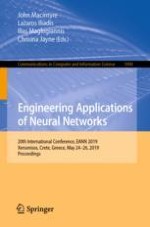
2019 | OriginalPaper | Chapter
The Power of the “Pursuit” Learning Paradigm in the Partitioning of Data
Authors : Abdolreza Shirvani, B. John Oommen
Published in: Engineering Applications of Neural Networks
Publisher: Springer International Publishing
Activate our intelligent search to find suitable subject content or patents.
Select sections of text to find matching patents with Artificial Intelligence. powered by
Select sections of text to find additional relevant content using AI-assisted search. powered by